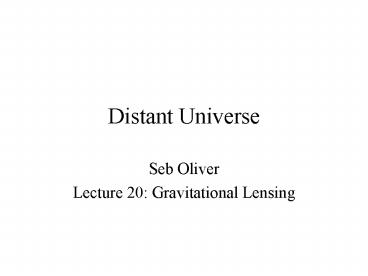Seb Oliver - PowerPoint PPT Presentation
1 / 28
Title:
Seb Oliver
Description:
The quasar 0957 561: the first multiply-imaged source discovered ... Quasar Timings ... Timing of multiply lensed quasars used to favour H0~50kms-1Mpc. Finding ... – PowerPoint PPT presentation
Number of Views:46
Avg rating:3.0/5.0
Title: Seb Oliver
1
Distant Universe
- Seb Oliver
- Lecture 20 Gravitational Lensing
2
What did Gravitational Lensing ever do for
cosmology?
3
The Lensing Equation
- Back of the envelope calculation to show that a4
GM/r
4
Lensing Phenomena
- Microlensing
- Strong-lensing
- Multiple images
- Einstein Rings
- Arcs
- Magnification
- Time delays
- Weak-lensing
- Magnification
- Distortion/shear
5
(No Transcript)
6
(No Transcript)
7
Micro-lensing
- MACHO (4 candidates 3 in bulge 1 in LMC)
http//wwwmacho.mcmaster.ca/index.html - EROS http//eros.in2p3.fr/
- OGLE I, II, III http//bulge.princeton.edu/ogle/
- MOA http//www3.vuw.ac.nz/scps/moa/
- PLANET http//mplanet.anu.edu.au/
- Now Catalogues of hundreds of microlensing events
8
MACHO EROS
9
Constraints on Halo Mass
10
Micro-lensing searches today
11
Strong Lensing
12
Multiple Lensing
The quasar 0957561 the first multiply-imaged
source discovered by Dennis Walsh, Bob Carswell
Ray Weymann in 1979.
The multiply-imaged pair discovered in the
cluster AC114 by Ian Smail and Richard Ellis with
the HST.
13
What can you do with multiple lensed systems?
- Measure the positions of the images
- Measure the relative magnification of the images
- Measure the difference in time-delays
- Model the mass distribution of the lens
- Relate proper distance (from time-delays) to
redshifts and deduce Hubble Constant and
acceleration constant - Count them
14
Modelling the mass distribution
- Postulate a lens mass distribution
- this might be
- Related to the light distribution
- Simple isothermal model with few parameter
- Postulate a source light distribution
- Hence predict observed light distribution
- Compare with observations
- Repeat steps 1-4 until suitable agreement
15
Quasar Timings
16
Time-delays
17
Arcs
Abell 2218 taken with the HST Jean-Paul Kneib,
Richard Ellis and Ian Smail.
18
Einstein Rings
Rings provide strong constraints on models of the
lens mass distribution
19
(No Transcript)
20
(No Transcript)
21
Weak Lensing
22
Weak Lensing
The average elongation of background sources
provides additional constraints on models of mass
distribution
23
Weak Lensing Shear
The weak shear observed by Yannick Mellier and
colleagues in the periphery of the rich cluster
002416. Such measurements offer a promising
method of tracing the dark matter profile and
constraining the total mass density contributed
by clusters of galaxies
24
Weak Lensing Shear
Grey et al. from COMBO-17 data
25
Weak Lensing Shear
Grey et al. from COMBO-17 data
26
What can lensing tell us?
- Mass of dark matter in Halo
- Micro-lensing
- Dark mass in external galaxies
- Modelling of multiply lensed systems
- Dark mass in clusters W0.35 0.07 (Turner 1999)
- Modelling of multiply lensed systems, arcs, and
statstical sheer - Magnification from statistical analysis of counts
- Dark mass in field
- Inversion of sheer fields
27
What else?
- Hubbles constant
- Timing of multiply lensed quasars used to favour
H050kms-1Mpc - Finding distant galaxies
- Surveys targeted at clusters to
- magnify background galaxies
- separate galaxies to reduce confusion
- Cosmological parameters
- Lensing probabilty
- Timing
28
References
- Yannick Mellier PROBING THE UNIVERSE WITH WEAK
LENSING Annu. Rev. Astron. Astophys. 1999, Vol.
37 127-189 - Alexandre Refregier Weak Gravitational Lensing by
Large-Scale Structure Annu. Rev. Astron.
Astophys. 10.1146/annurev.astro.41.111302
.102207. - RD Blandford and R Narayan Cosmological
Applications of Gravitational Lensing Annu. Rev.
Astron. Astophys. 1992, Vol. 30 311-358 - Bohdan Paczynski GRAVITATIONAL MICROLENSING IN
THE LOCAL GROUP - Annu. Rev. Astron. Astophys. 1996, Vol. 34
419-459 - Fahlman, G.G., Kaiser, N., Squires, G. Woods,
D. 1994,"Dark matter in ms1224 from the
distortions of the background galaxies," Ap. J.
437, 56. - Kaiser, N. Squires, G. 1993, "Mapping the dark
matter with weak gravitational lenses," Ap. J.
404, 441. - Refsdal, S. 1964, "The gravitational lens
effect," M.N.R.A.S. 128, 295. - Schneider, P., Ehlers, J. Falco, E. 1992,
Gravitational Lenses. Springer-Verlag, Berlin. - Surdej, J. Soucail, G. 1993, "Lists of
accepted and proposed gravitational lens
systems," in Surdej, J. et al (eds.)
Gravitational Lenses in the Universe, 1993,
Proceedings of the 31st Liège International
Astrophysical Colloquim. - Walsh, D. and Carswell, R.F. and Weyman, R.J.
1979, "0957561 A,B twin quasistellar
objects or gravitational lens?" Nature, 279, 381.
- Gravitational Lensing Nature's Giant Telescopes
Jean-Paul Kneib Richard Ellis
http//webast.ast.obs-mip.fr/people/kneib/ast_now9
6/































